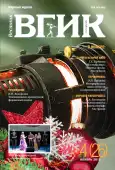Том 7, № 4 (2015)
- Год: 2015
- Статей: 13
- URL: https://journals.eco-vector.com/2074-0832/issue/view/880
- DOI: https://doi.org/10.17816/VGIK74
ХРОНИКА В ДЕТАЛЯХ | АКТУАЛЬНОЕ СОБЫТИЕ
В фокусе - кино молодых
 6-6
6-6


ТЕОРИЯ И ИСТОРИЯ КИНО | ЭКРАННЫЕ ИСКУССТВА
К социологической рационализации государственной кинополитики
Аннотация
В статье проводится мысль, что государственная кинополитика рациональна постольку, поскольку умна. Рационализировать ее нынешнее состояние - значит прежде всего усиливать наукоемкость, более полно и глубоко использовать социологическое и прочее научное знание о динамичной картине кинематографической жизни общества и скрытых ее законах.
 8-19
8-19


Шестидесятые. Полвека спустя. Ностальгия
Аннотация
Грустные наблюдения за бедностью творческого поиска в современной практике отечественного документального кино побуждают к ностальгическому вниманию, к опыту полувековой давности, - подъему творческого поиска в документальных фильмах «шестидесятников». В статье рассматривается как социально-психологическая атмосфера, сформировавшая «нравственную солидарность» поколения, посвятившего себя новаторскому обновлению экранной документалистики, так и основные грани преображения эстетики документального экрана в эти годы.
 20-30
20-30


КИНОЯЗЫК И ВРЕМЯ | ГЕНЕЗИС ОБРАЗА
 32-49
32-49


Реконструкция как метод изображения человека в документальном кино
Аннотация
На широком историческом фоне изучается метод реконструкции в современном российском документальном кино. Жизнь может изображаться на экране с использованием постановочных средств с целью драматизации или восстановления реальности. Картины же, объединенные термином «мокьюментари», строятся на вымышленных историях, «загримированных» под документ. В одном их варианте авторы проводят жесткие игровые эксперименты, в другом - с максимальной достоверностью рассказывают о том, чего не было.
 50-61
50-61


ПЕРФОРМАНС | ИСКУССТВО ВОПЛОЩЕНИЯ
 64-72
64-72


Экранизируя Зурбаган: к опыту использования анимации в российском игровом кино
Аннотация
В качестве предмета исследования выступают экранизации прозы Александра Грина, объекта - особенности кинематографического взгляда на образы яркого представителя прозы «Серебряного века». Статья носит историко-теоретический характер, ее цель - ввести в научный оборот ранее неизвестные архивные документы (на материале фондов РГАЛИ, к/ст. «Мосфильм») и экспериментальные съемки, которые уточняют историю использования специальных эффектов в отечественном кино. Анализ фильмов, осуществленный автором статьи, позволяет говорить об эволюции эстетических взглядов на природу фантастики в кино в 1960-2010 годах. Практическая значимость статьи состоит также и в том, что она раскрывает малоизвестные аспекты творчества выдающихся отечественных аниматоров.
 73-83
73-83


КУЛЬТУРА ЭКРАНА | КУЛЬТУРОЛОГИЯ. ФИЛОСОФИЯ
Вера как одна из универсальных категорий бытия
Аннотация
В статье предпринята попытка рассмотреть философскую категорию ВЕРЫ, ее трактовку в художественном произведении с позиций изменения времени, связывая эти перемены с социальными подвижками, сменой парадигмы, где «теле сное» начинает преобладать над духовным, а также возрастанием роли науки. И потому потребность в Боге для объяснения Вселенной становится все ничтожнее в связи и с этой материализацией представлений о мире.
 86-98
86-98


МИРОВОЙ КИНОПРОЦЕСС | АНАЛИЗ
Европейский киноавангард: диалектика «игрового» и «неигрового»
Аннотация
Статья подводит итог ранним этапам формирования методологии «феноменологической интерпретации реальности» в контексте европейского киноавангарда. Объектом анализа становится дихотомия «игрового» и «неигрового» начал в эстетике «документалистского» стиля и поэтического сознания на материале фильмов Дмитрия Кирсанова, Йориса Ивенса, Лукино Висконти.
 100-110
100-110


Тема Апокалипсиса в кинематографе Австралии
Аннотация
Статья посвящена анализу фильмов австралийских режиссеров, главной темой которых стал Апокалипсис. Термин «апокалипсис» часто употребляется как синоним конца света или катастрофы планетарного масштаба. В мире созданы сотни лент разного уровня таланта и мастерства, действие которых развивается до, во время или после какой-либо глобальной катастрофы. Причины, вызвавшие апокалипсис, могут быть разные: термоядерная война, вторжение инопланетян, восстание машин, гигантский метеорит, неизвестная науке болезнь и т. д. Но результат всегда один: человечество перестает существовать... Австралийские кинематографисты также не остались в стороне от зарубежных коллег и представили на суд зрителей немалое количество лент, повествующих о конце света, среди которых немало по-настоящему интересных и значительных картин.
 111-120
111-120


ТЕЛЕВИДЕНИЕ | ЦИФРОВАЯ СРЕДА
Телевизионная драматургия: форматный подход
Аннотация
В статье анализируется проблема телеформатов и их драматургической основы. В отличие от кинофильма, телезрелище прежде всего повторяемо: в его основе лежит тиражируемая драматургическая конструкция, наполняемая в каждом выпуске передачи новым содержанием. Необходимость обеспечить устойчивую коммуникацию с телеаудиторией заставляет вырабатывать особые правила, инструменты и приемы драматургии, объединяемые рабочим термином «телевизионный формат». В основе форматной драматургии лежит последовательное моделирование предсказуемых зрительских реакций. Формат рассматривается вне конкретного смыслового наполнения: как структурная модель; как динамическая система; как набор многоуровневых кодов.
 130-142
130-142


Моделирование эволюции медиа. Проекция развития
Аннотация
 143-150
143-150


ЗАРУБЕЖНОЕ КИНО В ЛИЦАХ | ТВОРЧЕСКИЙ ПОРТРЕТ
Наоми Кавасэ: вечное и преходящее
Аннотация
Наоми Кавасэ - одна из самых известных японских женщин-режиссеров, неоднократно удостаивалась наград Международного кинофестиваля в Каннах. Она попеременно работает то в художественном, то в документальном кино, не проводя между ними абсолютно четкой границы. Её излюбленные темы - рождение и смерть, единение человека и природы, наиболее характерная стилистическая особенность - технический минимализм. Почти неизменное место действия в фильмах - родина Кавасэ район Нара.
 121-127
121-127













